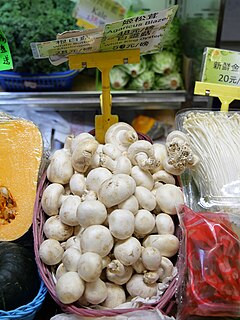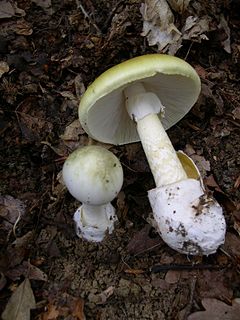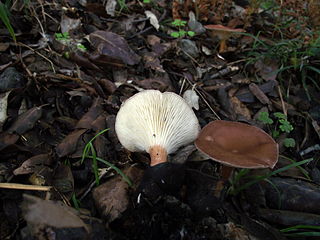
Acetylene (systematic name: ethyne) is the chemical compound with the formula C2H2. It is a hydrocarbon and the simplest alkyne. This colorless gas (lower hydrocarbons are generally gaseous in nature) is widely used as a fuel and a chemical building block. It is unstable in its pure form and thus is usually handled as a solution. Pure acetylene is odorless, but commercial grades usually have a marked odor due to impurities.

Edible mushrooms are the fleshy and edible fruit bodies of several species of macrofungi. They can appear either below ground (hypogeous) or above ground (epigeous) where they may be picked by hand. Edibility may be defined by criteria that include absence of poisonous effects on humans and desirable taste and aroma.

Mushroom poisoning refers to harmful effects from ingestion of toxic substances present in a mushroom. These symptoms can vary from slight gastrointestinal discomfort to death in about 10 days. The toxins present are secondary metabolites produced by the fungus. Mushroom poisoning is usually the result of ingestion of wild mushrooms after misidentification of a toxic mushroom as an edible species. The most common reason for this misidentification is close resemblance in terms of colour and general morphology of the toxic mushrooms species with edible species. To prevent mushroom poisoning, mushroom gatherers familiarize themselves with the mushrooms they intend to collect, as well as with any similar-looking toxic species. The safety of eating wild mushrooms may depend on methods of preparation for cooking.

Omphalotus illudens, commonly known as the eastern jack-o'lantern mushroom, is a large, orange mushroom that is often found in clumps on decaying stumps, buried roots or at the base of hardwood trees in eastern North America. Nearly all field guides claim its gills often exhibit a weak green bioluminescence when fresh; however, some dispute this entirely as a myth. On the other hand, the green glow, also known as bioluminescence, has been mentioned in several journals, stating that the glow can last up to 40-50 hours after the mushroom has been picked, and that the reason for the green glow is for the fungus to attract insects during the night in order for the insects to distribute the spores throughout the area.

Pleurotus ostreatus, the oyster mushroom or oyster fungus, is a common edible mushroom. It was first cultivated in Germany as a subsistence measure during World War I and is now grown commercially around the world for food. It is related to the similarly cultivated king oyster mushroom. Oyster mushrooms can also be used industrially for mycoremediation purposes.

Clitocybe is a genus of mushrooms characterized by white, off-white, buff, cream, pink, or light-yellow spores, gills running down the stem, and pale white to brown or lilac coloration. They are primarily saprotrophic, decomposing forest ground litter. There are estimated to be around 300 species in the widespread genus.

Clitocybe odora, also known as the aniseed toadstool, is a blue-green mushroom that grows near deciduous and coniferous trees. They can be found growing in small groups along the side of tree roots. This mushroom is edible, but a few expert mushroom hunters insist that young specimens should be avoided as can be confused with Stropharia aeruginosa. The anise odor is due to the presence of p-anisaldehyde and a small amount of benzaldehyde. This odor can give away the mushroom's presence before it is observed by eye.

Clitocybe nuda, commonly known as the wood blewit and alternately described as Lepista nuda, is an edible mushroom native to Europe and North America. Described by Pierre Bulliard in 1790, it was also known as Tricholoma nudum for many years. It is found in both coniferous and deciduous woodlands. It is a fairly distinctive mushroom that is widely eaten, though there is some caution about edibility. Nevertheless, it has been cultivated in Britain, the Netherlands and France.

Blewit refers to two closely related species of edible agarics in the genus Clitocybe, the wood blewit and the field blewit or blue-leg (C.saeva). Both species are treated by some authorities as belonging to the genus Lepista.
Opines are low molecular weight compounds found in plant crown gall tumors or hairy root tumors produced by pathogenic bacteria of the genus Agrobacterium and Rhizobium. Opine biosynthesis is catalyzed by specific enzymes encoded by genes contained in a small segment of DNA, which is part of the Ti plasmid or Ri plasmid, inserted by the bacterium into the plant genome. The opines are used by the bacterium as an important energy, carbon and nitrogen source. Each strain of Agrobacterium and Rhizobium induces and catabolizes a specific set of opines, this set typifying the Ti plasmid and Ri plasmid. There are some 30 different opines described so far.

Clitocybe dealbata, also known as the ivory funnel, is a small white funnel-shaped toadstool widely found in lawns, meadows and other grassy areas in Europe and North America. Also known as the sweating mushroom, it derives this name from the symptoms of poisoning. It contains potentially deadly levels of muscarine.

Clitocybe rivulosa, commonly known as the false champignon or fool's funnel, is a poisonous basidiomycete fungus of the large genus Clitocybe. One of several species similar in appearance, it is a small white funnel-shaped toadstool widely found in lawns, meadows and other grassy areas in Europe and North America. Also known as the sweating mushroom, it derives this name from the symptoms of poisoning. It contains potentially deadly levels of muscarine.

Ampulloclitocybe clavipes, commonly known as the club-foot or club-footed clitocybe, is a species of gilled mushroom from Europe and North America. The grey brown mushrooms have yellowish decurrent gills and a bulbous stalk, and are found in deciduous and conifer woodlands. Although considered edible, disulfiram-like reactions have been reported after consumption of alcohol after eating this mushroom.

Leucopaxillus giganteus, commonly known as the giant leucopax or the giant funnel, is a saprobic species of fungus in the family Tricholomataceae. As its common names imply, the fruit body, or mushroom, can become quite large—the cap reaches diameters of up to 50 cm (20 in). It has a white or pale cream cap, and is funnel-shaped when mature, with the gills running down the length of the stem. Considered by some to be a choice edible when young, this species has a cosmopolitan distribution, and is typically found growing in groups or rings in grassy pastures, roadside hedges, or woodland clearings. It has been shown to contain a bioactive compound with antibiotic properties.

Infundibulicybe is a genus of fungi that is robustly placed incertae sedis as sister group to the Tricholomatoid clade. It has previously been part of the family of Tricholomataceae, but recent molecular phylogeny has shown it to take an isolated position within the Agaricales.

Paralepista flaccida is a species of mushroom found across the Northern Hemisphere. It is known to form fairy rings.

Infundibulicybe mediterranea is a species of agaric fungus in the family Tricholomataceae. Found in Mediterranean Europe, it was described as new to science in 2011. It is closely related to Infundibulicybe gibba, but can be distinguished from that species by its darker colored fruitbody and smaller spores, which measure 4.5–6 to 3–4 µm. The fungus is edible. It fruits singly in groups, or occasionally in rings under oaks, such as Quercus suber and Quercus ilex.

Infundibulicybe gibba is a species of gilled mushroom which is common in European woods. In English it is sometimes known as the common funnel.

















